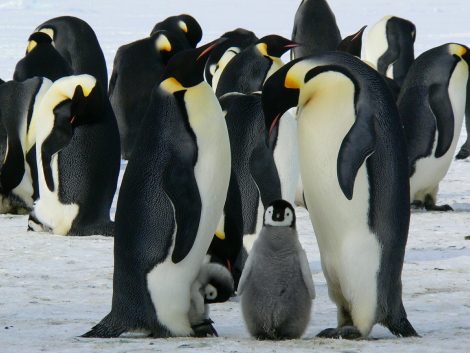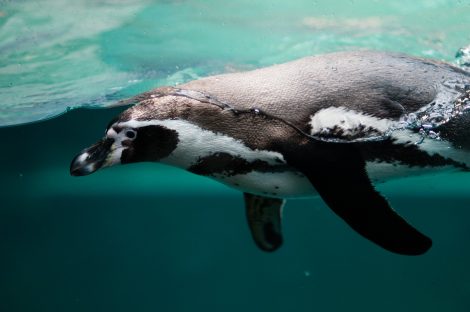Penguins live in some of the most inhospitable regions of the world. Even in these regions, penguins have predators in water and on land. Have you ever thought how do penguins protect themselves from predators? Well, penguins have evolved to develop several strategies that give them an advantage against predators that might be looking to hunt the penguins or their chicks.
Whether on land or in water, penguins can escape and evade their predators most of the times, but at times the predators get an upper hand. If hunted too much, penguin population can face a decline which is why many penguin species are now placed under endangered species list. As a protected species, penguins are safe from being hunted by humans as it is punishable by law. Any risk that penguins face is either from the weather, other penguins, and land or sea-based predators.
In water, sharks, leopard seals, and sea-lions are some of the most vicious predators that hunt penguins. Let’s take a look at some of the ways in which penguins can save themselves from these predators.
1) Fast Swimming
In water, penguins have several predators that can vary from leopard seals to orcas and more. Luckily for penguins, they are blessed with impressive swimming abilities and they can move quickly underwater. Penguins have strong flippers that they use to the best of their abilities to evade predators by swimming fast.
They can also change their direction quickly in the water to confuse their predators. Their torpedo-shaped body allows them to zoom through the water and they use their tail as a rudder to move and change their swimming direction swiftly. Penguins are also known for jumping out of the water with great force so that they land at a distance from the shoreline. This behavior helps them escape from any predators that might be lurking near the edge of the water.
2) Camouflage
Almost all penguins have excellent natural camouflage abilities called countershading. As their back is covered in dark feathers and their chests are covered in light-coloured feathers, they are able to escape detection in the water. For predators looking at penguins from above, they are not visible as the black on their back merges with the darkness of the seabed. For predators observing from below, the white of the penguin’s chest merges with the light color of the sky above. This kind of camouflage ensures penguins are safe from predators in the water.

3) Huddling to Protect Chicks
Emperor penguins huddle together to save each other from the harsh cold of the Antarctic. The huddling behavior also helps them to keep the chicks safe from any predators that might be lurking at the edges of the huddle. Any birds looking to snatch penguin chicks from above are also discouraged as they are not able to penetrate the huddle.
Small chicks stay safe from the cold in the center of the huddle and penguins keep rotating from center to the edges of the huddle. By rotating their position, penguins make sure any weak or tired penguins get the benefit of the safety of the middle of the huddle and they are not hunted by predators.

4) Gathering in Large Numbers
By gathering in large numbers, penguins keep any potential predators away from their location. A large number of penguins often dissuades smaller predators such as cats and foxes from hunting the penguins. Penguins might also help other penguins if they are at risk of getting taken by a predator.
5) Loud Squawking
Small penguins like African penguins can be loud. Their loud braying has also made them popular as jackass penguins. The loud sounds they make are often a deterrent for any predators that might be looking to hunt the penguins. In case there are any predators nearby, the penguins also warn each other by making loud braying noises.
6) Intimidating Gestures
Penguins will often flap their flippers and make threatening gestures with their beak if they face any predators that are of similar size. In case a predator is larger in size or too dangerous, the penguin will abandon their chicks or eggs in order to save their own life.
7) Burrows
New Zealand’s Little Penguins face the risk of predation from several land-based predators. These penguins spend most of their day in the water and come to the shore only when their land-based predators are sleeping. Little penguins also dig burrows and sleep in their burrows during the day to keep safe from predators like cats, dogs, and foxes.
Conclusion
Penguins are social creatures and their survival depends on various social cues and activities that help them to escape predators. As they stay together in groups, they are also able to escape from predators by warning each other and also by intimidating predators with their large group size. A large group means weaker penguins also get protection from predators by a great degree.
So, next time someone asks you how penguins protect themselves from predators, you will be able to give a better answer based on the points discussed in this article. If you have any thoughts or views about penguins and how they escape predators, please feel free to discuss in the comment section.
References
https://phys.org/news/2016-07-king-penguins-ear-predators.html
https://www.macalester.edu/~montgomery/BlackFootedPenguin.html
https://www.birdlife.org/worldwide/news/protect-penguin-today
WHAT IS A PENGUINS DIET?